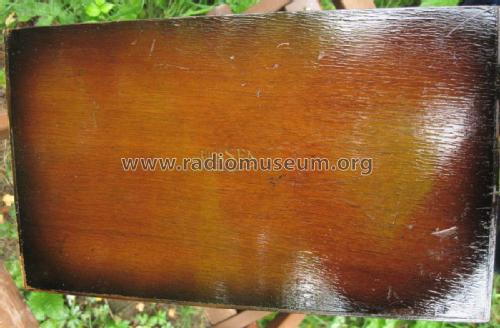Two Valve Portable Battery
Lissen Ltd.; London and Richmond, Surrey
- Land
- Grossbritannien (UK)
- Hersteller / Marke
- Lissen Ltd.; London and Richmond, Surrey
- Jahr
- 1932
- Kategorie
- Rundfunkempfänger (Radio - oder Tuner nach WW2)
- Radiomuseum.org ID
- 282858
Klicken Sie auf den Schaltplanausschnitt, um diesen kostenlos als Dokument anzufordern.
- Anzahl Röhren
- 2
- Hauptprinzip
- Geradeaus allg. (mit oder ohne Rückk.); 1 NF-Stufe(n)
- Wellenbereiche
- Langwelle, Mittelwelle (LW+MW).
- Betriebsart / Volt
- Akku und/oder Batterie
- Lautsprecher
- Magnetischer Lautsprecher allgemein, System nicht definiert / Ø 11 inch = 27.9 cm
- Material
- Gerät mit Holzgehäuse
- von Radiomuseum.org
- Modell: Two Valve Portable [Battery] - Lissen Ltd.; London and
- Abmessungen (BHT)
- 362 x 336 x 190 mm / 14.3 x 13.2 x 7.5 inch
- Bemerkung
-
Clip in Metal rear panel.
Price approximate, one ot the cheaper models at Manchester Radio Show, 28th September 1932
Mullard lists PM1A and PM22A for the Lissen "Transportable 2", which is either the same model or an almost identical model.. The HL2 and PT225 are typical Lissen rebadging of these (see similar era Lissen Skyscraper kits)
See forum notes and the AC mains version
- Originalpreis
- 3.75 GBP
- Literaturnachweis
- -- Original prospect or advert (Page 319 September 30th 1932 Wireless World)
- Autor
- Modellseite von Michael Watterson angelegt. Siehe bei "Änderungsvorschlag" für weitere Mitarbeit.
- Weitere Modelle
-
Hier finden Sie 159 Modelle, davon 124 mit Bildern und 58 mit Schaltbildern.
Alle gelisteten Radios usw. von Lissen Ltd.; London and Richmond, Surrey
Sammlungen
Das Modell Two Valve Portable befindet sich in den Sammlungen folgender Mitglieder.
Forumsbeiträge zum Modell: Lissen Ltd.; London: Two Valve Portable
Threads: 1 | Posts: 3
or Informed speculation?
This was one of the cheapest models on 28th September 1932 at the Manchester Radio Show. It would be reasonable to assume it's basically a battery version of the 2 valve mains model featured in November 1932 Wireless World.
That would mean it would have used an HL2 or similar for detector and PT225 or similar for speaker driver, probably Mullard made with Lissen bases. There would have been three HT taps to save resistors and capacitors, the primary of transformer on HL2 anode, the screen of PT225 and the supply to speaker motor.
The top knob is likely the tuning with a 0 to 100 scale, middle wire to short LW coil for MW operation, lower knob the reaction. The 2V LT switch probably in the lower slot. The 120V tapped HT pack and 9V tapped GB pack would not have been switched, to save money. Likely one grid leak resistor on HL2 and just two fixed capacitors, RF coupling to grid and RF decoupling on HL2 anode. Transformer (1:2 or maybe as high as 1:5) to couple the valves.
The aerial and earth wires via a cut out corner on back plate. The blocks to position the 2V Lead acid cell and standard tapped 120V dry cell battery pack can be seen on the base of the case. I assume the tapped 9V grid bias pack clipped to the chassis, held by four screws to side of case with the control panel cut-out. There are no other mounting holes.
Michael Watterson, 16.Jun.16





